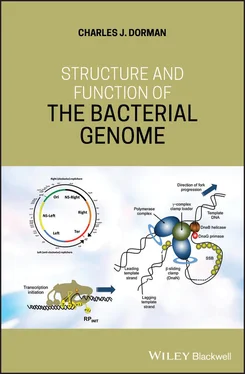Once F has become one with the chromosome, it is replicated as a part of that molecule. It can still engage in conjugation, however. When this happens, the DNA that is transferred to the F −female bacterium consists of chromosomal DNA with F DNA in the vanguard. Strains that can act as DNA donors in these matings are called ‘Hfr’ (high frequency of recombination) (Reeves 1960) and homologous recombination between the incoming, horizontally transferred DNA and the resident chromosome allows the order of the genes on the chromosome to be determined. Experiments, in which chromosomal gene transfer mediated by the F plasmid was monitored as a function of time, allowed a rudimentary genetic map of the E. coli chromosome to be assembled (Bachmann 1983; Brooks Low 1991). Because the mating experiments were allowed to proceed for fixed periods of time before the deliberate breakage of the conjugation bridges by mechanical shearing, these early genetic maps were calibrated in ‘minutes’. It was discovered that it took 100 minutes to transfer the entire E. coli chromosome from one cell to another by conjugation (Bachmann 1983; Brooks Low 1991). Similar experiments were performed for other bacterial species, including the pathogen Salmonella , giving rough approximations of the physical scale of bacterial genomes (Sanderson and Roth 1988). Hfr strains could also mediate gene transfer between E. coli and Salmonella (Schneider et al. 1961). When the F plasmid is excised from the chromosome, genes that had been adjacent to the plasmid can be removed too, becoming part of the autonomously replicating episome. The plasmids are called F‐prime (F′) and have proved to be very useful in genetic analysis. The chromosomal gene ‘cargo’ can be transferred to F‐minus strains by conjugation and this phenomenon can be exploited in genetic complementation experiments. Work of this type provided useful information about gene order and the position and nature of genetic mutations. F‐primes have been used to investigate plasmid stability, incompatibility, and DNA replication: for example, the F′‐ lac episome was used extensively to study plasmid replication in E. coli (Davis and Helmstetter 1973; Dubnau and Maas 1968). Experiments with E. coli mutants deficient in Hfr recombination led to the discovery of important genes involved in homologous recombination: for example, recA (Clark and Margulies 1965), recB , and recC (Barbour and Clark 1970; Willetts et al. 1969; Youngs and Bernstein 1973).
HGT also provided a means for more refined mapping of genomes. Bacteriophages (often abbreviated to ‘phages’) are viruses that replicate in bacterial cells. Some phages package bacterial DNA in their viral heads as they exit the bacterial host and this DNA is transferred to the next bacterium that they manage to infect in a process known as transduction. The length of the DNA segment that a phage head can accommodate is finite and known in the cases of the viruses most commonly used for generalised transduction in E. coli (P1, 100–115 kb) and Salmonella (P22, 42 kb) (Sternberg and Maurer 1991). Therefore, genes that are co‐transduced must be within a distance of one another that is compatible with being co‐packaged by the phage. Very sophisticated experiments with transducing phage allowed not only gene‐to‐gene distance relationships to be determined but also the measurement of the physical relationships between features of individual genes, such as their regulatory elements.
Thus, HGT has driven bacterial evolution and microbial geneticists have exploited it to assemble the first genetic maps of bacterial genomes. Genetic engineers have also used HGT to build novel variants of bacterial genomes in the lab. Cloning experiments using vectors based on natural or engineered plasmids rely on the HGT process known as transformation to move new DNA sequences into bacterial cells. A bacterium that is susceptible to transformation is said to be ‘competent’ and competence can be induced chemically or by electric shock (Hanahan et al. 1991). In addition, many bacterial species are naturally competent and therefore open to the uptake of foreign DNA from the environment. Knowledge and application of the HGT processes of transformation, transduction, and conjugation have revolutionised our understanding of bacterial genomes in a matter of decades. Genome sequencing has extended and deepened this knowledge.
Foreign DNA entering bacterial cells may undergo surveillance. Much attention has been focused on clustered regularly interspaced short palindromic repeat (CRISPR) systems both in their natural roles as systems that identify and destroy ‘non‐self’ DNA, and as a result of their promise as agents of genome editing (Barrangou et al. 2007; Brouns et al. 2008; Garneau et al. 2010). Restriction endonucleases and their associated DNA methylases represent another mechanism for defending the bacterial cell from foreign DNA. Here, the methylases chemically modify the newly synthesised DNA of the bacterial genome so that it matches the ‘approved’ pattern: incoming DNA that lacks this methylation pattern is cut into pieces by the restriction endonucleases. These DNA surveillance mechanisms help to control the access of foreign DNA to established genomes.
The concepts of ‘foreign DNA’ and ‘established genomes’ can also be expressed by the terms ‘accessory genome’ and ‘core genome’, respectively. ‘Accessory’ implies that portion of the genome is not essential for the life of the bacterium, and that may be true in the artificial environment of the laboratory. The name also suggests that some form of value is added to the life of the organism, but that this is conditional. In fact, the same can be said of any gene or portion of the genome. In some cases, the essential nature of a genome component is made obvious because the bacterium dies if this component is eliminated. However, this can apply to a portion of the accessory genome just as much as to one of the core genome, depending on the circumstances of the bacterium. A facile example concerns the presence in a bacterium of a gene encoding resistance to penicillin. The gene is not a part of the core genome (it may even be located on a plasmid and not on the chromosome) and it is not essential unless penicillin‐class antibiotics appear in the neighbourhood. In the absence of this gene during periods of cell wall peptidoglycan synthesis, the bacterium dies if penicillin‐class antibiotics are introduced; despite being a part of the accessory genome, the resistance gene is now an essential gene.
The accessory genome is distinguished from the core genome in being of more recent arrival in the cell. It is not a monolithic entity but a mosaic of imported genetic components that have arrived through HGT, possibly over a very long period of time. In this context, it is very important to realise that genome evolution is not only a process of gene acquisition: gene loss is equally important. A gene may be lost safely if another member of the genome can supply its function, if the cell can acquire the lost product from an exogenous source, or if the selective pressure to retain the gene has been removed.
The core genome consists of those genes that are essential for the life and reproduction of the cell and that are widely shared by other organisms, even those that are only distantly related. Thus, the analysis of genome composition using computers to compare and contrast the genes possessed by thousands of bacteria has helped to identify those genes that are truly almost universally present in bacteria. These designations of essentiality have been supported in some cases by experiments in which the genes have been removed and the impact of their loss on the survival of the bacterium has been measured (Baba et al. 2006; Gerdes et al. 2003; Goodall et al. 2018; Rousset et al. 2018). Essential genes include those whose products replicate the genome, transcribe the genes, translate the messages, and operate the principal metabolic pathways of the cell. In many cases, redundancies are revealed where more than one gene can contribute to an essential process. For example, E. coli has seven operons that contribute to the building of ribosomes, so losing one is not life threatening. On the other hand, the loss of even an apparently redundant gene might impose a fitness cost when a bacterium that has lost this gene competes with one that has not (Condon et al. 1995a).
Читать дальше












